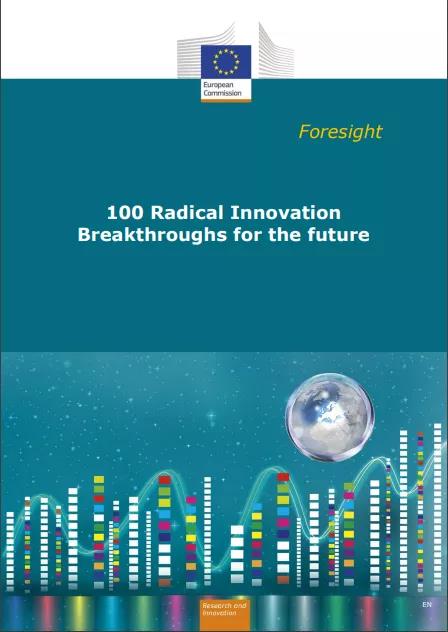The European Commission (EUROPEAN COMMISSION) released the report "100 Radical Innovation Breakthroughs for the future", a strategic resource for all those concerned with science, technology and innovation decisions. The report uses large-scale text mining of the latest science and technology literature, combined with expert advisory commentary, to screen 100 disruptive technologies that could have a significant impact on the global economy and inform possible priorities for future EU research and innovation policy.

This article compiles the key points of bioplastics, biodegradable, CCUS and synthetic biology related technologies for industry discussion.
Biodegradable Sensors
Biodegradable electronics are electronic components that have a limited lifetime and can be reacted by hydrolysis or biochemically. Such devices can be used as medical implants for temporary in vivo sensing, drug delivery, tissue engineering, microfluidics, etc. Materials that degrade naturally through biological or chemical processes are commonly used in food and pharmaceutical packaging. Biodegradable electronics can make devices smarter, such as temperature or chemical monitoring.
Currently, the life expectancy of electronics may be only a few months, and the ecological impact of discarded electronics is a concern that could be addressed by using biodegradable or organic electronic materials. This material opens the way for fully biodegradable, biocompatible/biometabolizable electronic devices that may dissolve at the end of their life cycle, which on the one hand will curb e-waste generation and on the other hand make possible the development of medical implants.
Bioelectronics
Bioelectronics is a technology that uses biological materials or biological architectures to design and manufacture information processing machinery and related devices. This field makes use of biofuel cells, bionics and biomaterials for information processing, information storage, electronic components and actuators. An important direction in this research area is the complementarity and interactions between biomaterials and small electronic devices. Researchers develop bio-inspired materials and hardware architectures for novel sensors, actuators and information processing systems. Other uses of this field include molecular manufacturing at the atomic scale, better connections between biological organs and electronic devices, which may drive human progress in prosthetics, human-machine integration, bionics, and other fields. It will also open up new perspectives for health modeling, monitoring and cell development studies. Synthetic DNA is millions of times more compact as a storage medium than most contemporary cutting-edge alternatives. On the other hand, in vivo storage systems can be used not only to store data, but also to record events and processes in human cells, tissues or engineered organs.
Bioplastic
Bioplastics refer to plastics produced by the action of microorganisms based on natural substances such as starch. It has renewable properties and is therefore very environmentally friendly. These include corn, rice, potato, palm fiber, cassava, wheat fiber, lignocellulose and bagasse. Depending on their chemical composition and percentage of bio-based components, bioplastics may be biodegradable. Bioplastics are used in industries as diverse as food and beverage packaging, healthcare, textiles, agriculture, automotive or electronics. The main advantage of bioplastics is that they leave a much smaller energy footprint and produce less pollution. The EU self-help project is working on a biodegradable diaper, a biodegradable bioactive beauty mask, and a nanostructured biocompatible nonwoven. Researchers at the University of Seville and the University of Huelva have developed a bioplastic using soy protein that is biodegradable and environmentally friendly and can absorb up to 40 times its own weight in water. The team modified the molecular structure of soybeans, thereby altering the uptake characteristics so that they retained three times more water than usual. By injecting a solid concentrate of the protein into a mold, they created test tubes that were applied to horticulture. A group of researchers led by Xinlong Wang has developed electronic components made of biodegradable bioplastics. The developed electronics are made from a corn starch-derived bioplastic called polylactic acid (PLA). By blending metal-organic backbone nanoparticles with this bioplastic, they succeeded in developing materials with mechanical, electrical and flame retardant properties that can be used in electronics. The plastics industry is working to develop new ways to produce bioplastics from natural raw materials found in nature. Bioplastics are in high demand in many different fields and there will be many new applications for this material.
Carbon Capture and Sequestration
Carbon is an essential element for life on Earth. Anthropogenic carbon dioxide is one of the major greenhouse gases contributing to climate change, and managing it is one of the greatest social, economic and political challenges of our time. To avoid losing carbon to the atmosphere, carbon is collected and stored and disposed of at high CO2 emission sources, such as the smokestacks of various industrial and carbon-based power plants. Air capture technology can remove carbon from the air from anywhere in the environment. Carbon dioxide is separated from the air or flue gas by absorption and membrane gas separation techniques. The captured carbon dioxide or extracted carbon can be stored in mineral form because it reacts exothermically with metal oxides. In other cases, it can be transported by pipeline for use elsewhere, such as injection into old oil fields to extract oil.

